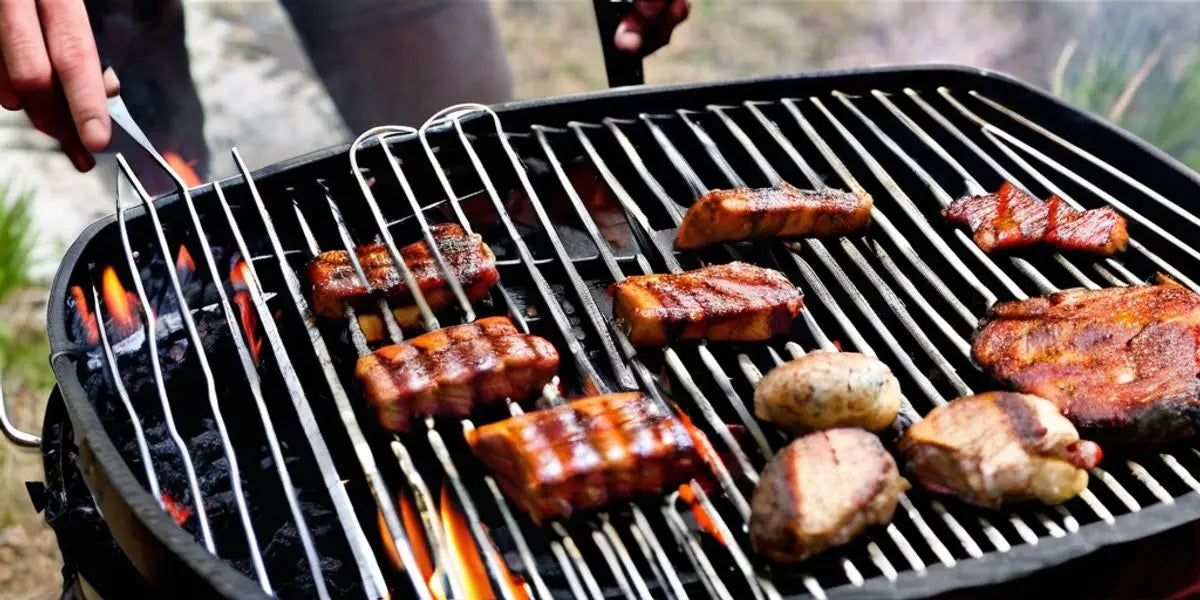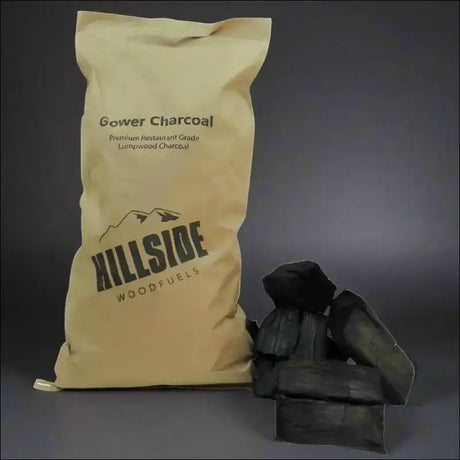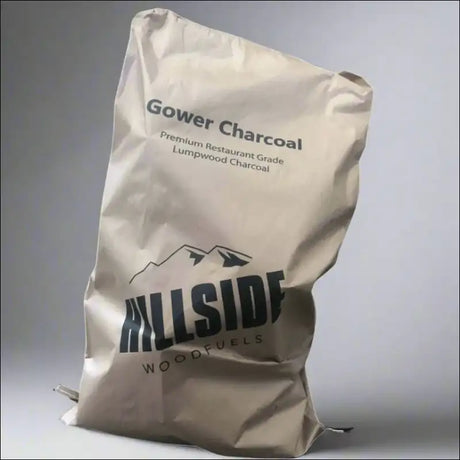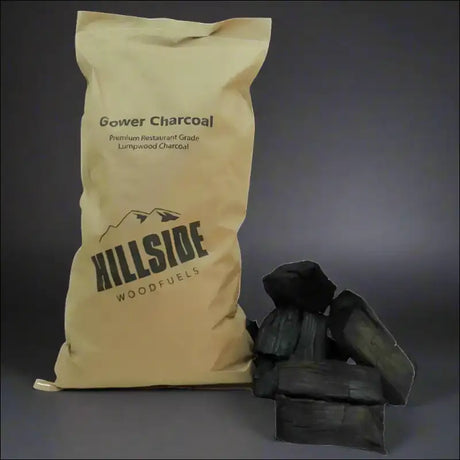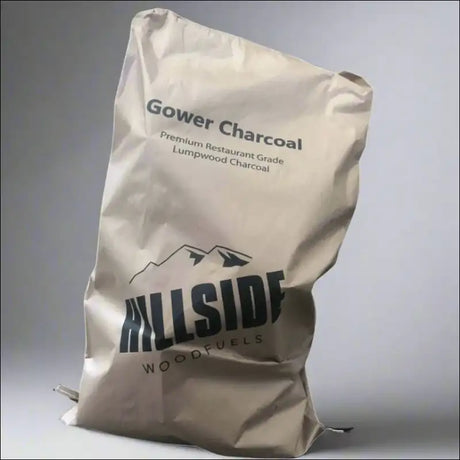The Art of Choosing the Right Lump Charcoal

Understanding Charcoal Varieties
When you're ready to master charcoal grilling, the first step is to understand the different types of charcoal available to you. Lump charcoal, known for its purity and ability to reach high temperatures, is a favorite among grilling aficionados. On the other hand, lumpwood charcoal offers a more traditional approach with its irregular shapes and sizes, providing a unique flavor profile to your dishes.
Here's a quick guide to help you distinguish between the two:
- Lump Charcoal: Burns hotter and cleaner, with less ash production.
- Lumpwood Charcoal: Offers a more natural and organic burn, with a distinct smoky flavor.
Remember, the quality of your grilling experience hinges on the charcoal you choose. High-quality charcoal, efficient lighting methods, and heat control through air flow are essential for a triumphant barbecue experience. Preventing flare-ups and experimenting with diverse recipes will further enhance your grilling rhythm.
Choosing the right charcoal is more than a practical decision; it's a commitment to the art of grilling. Embrace the process and let the distinct characteristics of each charcoal variety guide you to grilling perfection.
Factors Influencing Charcoal Quality
When you're on the hunt for the perfect lump charcoal, it's crucial to consider the factors that affect its quality. The density of the charcoal, for instance, influences how long it will burn and how steady the heat will be. A denser charcoal means a longer, more consistent burn, ideal for extended grilling sessions.
- Origin: The source of the charcoal can impact its burn properties and flavor profile.
- Wood Type: Different woods produce charcoals with varying heat outputs and aromas.
- Production Process: The method used to create the charcoal affects its purity and burn quality.
- Size and Shape: Uniform pieces ensure even heating, while irregular sizes can lead to unpredictable cooking temperatures.
Remember, the quality of your charcoal can make or break your grilling experience. Opt for a charcoal that complements your cooking style and the meats you're grilling. By choosing responsibly, you not only enhance the flavor of your food but also contribute to sustainable sourcing and minimize environmental impact.
Always check the packaging for clues about the charcoal's properties. Look for certifications or labels that indicate a high-quality product. And don't forget, the way you store your charcoal can also affect its performance. Keep it dry and well-ventilated to preserve its burning potential.
Selecting Charcoal for Different Meats
When it comes to grilling, the choice of lump charcoal can make a significant difference in the flavor and quality of your cooked meats. Different types of meat have unique characteristics and therefore benefit from specific types of lump charcoal. For instance, hardwood lump charcoal, known for its long-lasting heat, is ideal for grilling beef steaks that require high temperatures to sear properly.
- Poultry: For chicken and turkey, a milder fruitwood charcoal can impart a subtle, sweet flavor without overpowering the meat.
- Pork: Apple or cherry wood charcoal complements pork cuts, enhancing the natural sweetness of the meat.
- Fish: Use coconut shell charcoal for its mild flavor profile, which won't overshadow the delicate taste of fish.
Remember, the goal is to match the charcoal to the meat's flavor profile and cooking needs. Experimenting with different charcoals can lead to delightful discoveries and a mastery of the grilling process.
Always consider the burn time and temperature control that different charcoals offer. A slow-cooked brisket, for example, benefits from a charcoal that maintains a consistent temperature over a long period, while quick-grilling sausages might do well with a charcoal that lights easily and burns hot for a shorter time. Tailoring your charcoal choice to the meat you're grilling will elevate your barbecue to the next level.
Timing and Temperature: Secrets to Perfect Grilling

The Importance of Preheating
Preheating your grill is a step you should never skip. Think of it as warming up before a workout; it prepares your grill for the high-intensity task of cooking. Starting with a hot grill ensures that your meat will sear properly, locking in those juicy flavors and creating a desirable crust. Aim for a preheat time of at least 15 minutes for charcoal grills.
- Light the charcoal: Allow it to burn until it's covered with a thin layer of gray ash.
- Spread the charcoal: Arrange for direct or indirect cooking depending on your recipe.
- Check the temperature: Use a grill thermometer to ensure the grill has reached the desired temperature before adding your food.
Remember, patience during preheating sets the stage for the entire grilling process. A properly preheated grill can make the difference between good and great barbecue.
Master the art of charcoal grilling with chemical-free methods, proper preheating, and direct vs. indirect cooking for delicious, smoky flavors. Quality tools enhance the grilling experience. The rhythm of grilling is not just about the time spent over the flames, but also the crucial moments before the cooking begins.
Managing Heat for Different Cuts
Mastering the heat for various cuts of meat is crucial to achieving that perfect sear and juicy interior. Different thicknesses and textures require unique approaches to heat management. For example, a thick ribeye steak thrives on a high, direct heat to create a flavorful crust, while a delicate fish fillet might need a gentler, indirect heat to cook through without drying out.
Thickness, fat content, and whether the meat is bone-in or boneless, all play a role in how you should manage your grill's temperature. Here's a simple guide to help you navigate:
- Steak (1-inch thick): High heat, 4-6 minutes per side
- Chicken breast (boneless): Medium heat, 6-8 minutes per side
- Pork chops (1-inch thick): Medium heat, 5-7 minutes per side
- Fish fillets: Low heat, 3-5 minutes per side
Remember, the key to perfect grilling is not just time, but also the feel of the meat. Press gently on the surface; if it springs back quickly, it's likely done. Keep a close eye on the grill, as the difference between perfectly cooked and overdone can be a matter of minutes.
Adjusting the heat and moving cuts between direct and indirect heat zones can help manage flare-ups and ensure even cooking. With practice, you'll develop an intuitive sense for how to adjust the heat for each type of meat, leading to consistently excellent results.
Recognizing the Signs of Readiness
Mastering the art of grilling with lump charcoal means knowing when your food is perfectly cooked. Recognizing the signs of readiness is not just about time and temperature; it's about observing the subtle changes in color, texture, and aroma. Here's a quick guide to help you identify when your grilled delights are ready to be savored:
- Steak: Look for a deep, caramelized crust and clear juices pooling on the surface. Use the touch test for doneness - if it's soft to the touch, it's likely still rare; firmer textures indicate medium or well-done.
- Chicken: The meat should no longer be pink at the bone, and juices should run clear. An instant-read thermometer should read 165°F when inserted into the thickest part of the meat.
- Vegetables: They should be tender but still offer a bit of resistance. Grilled marks are a good sign they've been on the grill long enough to develop flavors.
Remember, the key to perfect grilling is patience and attention to detail. Keep a close eye on your food, and don't be tempted to rush the process.
Grill safely with lumpwood charcoal by ensuring proper ventilation, keeping a safe distance from flammables, and using long-handled tools. After grilling, allow the charcoal to cool completely before disposal. For optimal flavors, grill over ash-covered charcoal, maintain proper airflow, and strategically place your food on the grill.
Flavor Infusion: Techniques for Smoky Perfection

Choosing Wood Chips for Enhanced Aroma
The right wood chips can transform your grilling experience, infusing your meats with a smoky depth that tantalizes the senses. Start by matching the intensity of the wood's flavor with the type of meat you're grilling. For instance, mesquite has a strong, earthy profile perfect for beef, while applewood imparts a sweeter note ideal for pork or poultry.
- Mesquite: Bold, perfect for beef
- Hickory: Rich, great for pork
- Applewood: Mild, ideal for chicken
- Cherrywood: Subtle, complements all meats
Remember, the key to unlocking the full potential of wood chips is patience. Soak them in water for at least an hour before placing them on the coals to prevent burning and to ensure a steady release of smoke.
Experiment with different wood types and combinations to discover your personal preference. Keep in mind that the quality of your lump charcoal will also affect the outcome. High-quality charcoal ensures a consistent burn and can enhance the wood's aroma. As you master the rhythm of grilling, you'll find that the right wood chips make all the difference in achieving smoky perfection.
Balancing Smoke and Heat
Achieving the perfect balance between smoke and heat is crucial for that ideal smoky flavor without overcooking your food. Start by understanding your grill's ventilation system; proper airflow is essential for controlling temperature and smoke intensity. Here's a simple guide to help you manage the balance:
- Open vents increase oxygen flow, raising the temperature and reducing smoke.
- Closed vents limit oxygen, lowering the temperature and increasing smoke.
- Adjust the vents gradually to find the sweet spot for your specific grill and the meat you're cooking.
Remember, the type of wood chips you use also affects the balance. Hardwoods like hickory or oak impart a stronger flavor and are ideal for red meats, while fruitwoods like apple or cherry offer a milder taste, perfect for poultry or fish.
The key to mastering the rhythm of grilling is to listen to your food. Pay attention to the sizzle, the color of the embers, and the aroma wafting through the air. These sensory cues will guide you in making the right adjustments.
Always start with a moderate amount of wood chips to avoid overpowering your food with smoke. It's easier to add more chips later than to rectify a dish that's become too smoky. And don't forget, patience is an essential ingredient in grilling; allow the flavors to develop slowly over a consistent, controlled heat.
Marinades and Rubs: The Flavor Enhancers
Unlock the full potential of your grilling experience by mastering the art of marinades and rubs. These flavor enhancers are not just about adding taste; they're about creating a symphony of flavors that complement the natural savoriness of the meat.
-
Marinades: Think of them as a tenderizing bath that infuses meat with moisture and taste. A good marinade usually contains an acid (like vinegar or citrus juice), oil, and a blend of herbs and spices. For best results, allow your meat to marinate for several hours, or even overnight, in the refrigerator.
-
Rubs: These are dry blends of spices and herbs that are massaged into the meat's surface. They create a crust that not only adds a burst of flavor but also helps to seal in the juices. Apply your rub evenly and let it sit for at least 30 minutes before grilling.
Remember, the longer your meat soaks in these enhancers, the more pronounced the flavors will be. Don't rush the process; good things come to those who wait.
Experiment with different combinations to find what works best for your palate. Here's a simple table to get you started on your journey to flavor town:
| Ingredient | Marinade | Rub |
|---|---|---|
| Acid | ✔ | |
| Oil | ✔ | |
| Herbs | ✔ | ✔ |
| Spices | ✔ | ✔ |
Grill Maintenance and Lump Charcoal Care

Cleaning Your Grill for Optimal Performance
Keeping your grill in top condition is essential for ensuring that the lumpwood charcoal offers controllable heat and the authentic flavor you love. Start by removing any residual ash and food particles after each use. This not only prevents unwanted flavors from tainting your next barbecue but also extends the life of your grill.
To maintain consistent high heat output, inspect the grates and interior surfaces for grease buildup. A simple solution of warm water and mild detergent can work wonders, followed by a thorough rinse and dry. Remember, a clean grill is a happy grill, and it's the secret to easy lighting and a successful cookout.
Here's a quick checklist to keep your grill in prime condition:
- Empty the ash catcher regularly
- Scrub the grates with a grill brush after preheating
- Wipe down the exterior with a damp cloth
- Check for any wear and tear
By dedicating a little time to grill maintenance, you're not only ensuring optimal performance but also honoring the rhythm of grilling that turns a simple meal into a culinary event.
Storing Lump Charcoal the Right Way
Proper storage of lump charcoal is crucial to maintain its quality and ensure it's ready for your next grilling session. When it comes to restaurant grade lumpwood charcoal, special care is needed to preserve its superior burning qualities. Here are some tips to keep your charcoal in top condition:
- Keep it dry: Moisture is the enemy of charcoal. Store your bags in a dry place, away from the elements.
- Avoid ground contact: Place your charcoal on a raised platform or shelf to prevent it from absorbing moisture from the ground.
- Seal the bag: Once opened, seal the bag tightly to prevent air from entering and causing the charcoal to lose its potency.
Remember, the way you store your charcoal can be as important as the way you light it. By following these simple steps, you'll ensure that your charcoal remains ready to impart that perfect smoky flavor to your meats.
Additionally, consider the following guide to preparing and lighting lumpwood charcoal for BBQ perfection. Choose hardwood charcoal, arrange in pyramid, use proper lighting techniques, add charcoal as needed, and enhance flavor with wood chips. Preserve moisture with water pans or spritz bottles to maintain the ideal grilling environment for your meats.
Troubleshooting Common Charcoal Issues
When your grilling session hits a snag, it's often due to common charcoal issues that can be easily resolved. Here's a quick guide to help you get back to grilling with confidence:
- Fire Won't Start: Ensure your charcoal is dry and use natural firelighters for a chemical-free ignition.
- Uneven Heat: Arrange the charcoal evenly and control temperature with vents to avoid hotspots.
- Flavorless Food: Add wood chips to your charcoal to infuse smoky flavors into your meats.
- Difficult Clean-Up: Regularly clean your grill to prevent ash build-up and maintain optimal performance.
Remember, the key to mastering lump charcoal is understanding how to quickly address these issues without losing the rhythm of your grilling.
By keeping these BBQ tips in mind, you'll ensure that your lumpwood charcoal provides those authentic BBQ flavors that are celebrated worldwide. And when in doubt, refer back to this guide to troubleshoot and keep your grilling game strong.
Grilling Events and Competitions: Showcasing Your Skills

Preparing for a Grilling Contest
As you gear up for the grilling contest, it's essential to have a game plan. Start by familiarizing yourself with the contest rules and categories. Knowing whether you're grilling ribs, brisket, or seafood can significantly influence your preparation and cooking strategy.
Checklist for Contest Preparation:
- Research the event and its history
- Understand the judging criteria
- Select your best recipes and practice them
- Prepare a timeline for prep, cooking, and resting your meats
- Organize your cooking station for efficiency
Remember, the key to success in any grilling contest is not just the flavor of your dish but also your organization and time management. A well-structured approach can make the difference between a good showing and a championship win.
Lastly, ensure all your equipment is in top condition and you have backups for essential items. A malfunctioning grill or a forgotten spatula can throw off your rhythm. Good luck, and may your grilling skills shine on the day of the contest!
Networking with Fellow Grill Enthusiasts
As you immerse yourself in the grilling community, remember that networking is not just about exchanging business cards; it's about sharing experiences and knowledge. Engage with peers who understand the nuances of restaurant-grade charcoal and its impact on flavor and heat. Discuss the best practices for ventilation, temperature control, and efficient ignition methods. Here are a few tips to help you connect effectively:
- Attend local grilling events and competitions to meet like-minded individuals.
- Join online forums and social media groups dedicated to grilling enthusiasts.
- Share your own grilling stories and listen to others, fostering a mutual learning environment.
Embrace the camaraderie of the grilling community. Experiment with different techniques and enjoy the process of grilling. The insights you gain from fellow enthusiasts can enhance your skills and introduce you to new culinary possibilities.
Remember, the goal is to build lasting relationships that can support and inspire your grilling journey. Whether it's at a secluded woodland feast or a bustling steakhouse, every interaction is an opportunity to learn and grow as a grill master.
Learning from the Pros at BBQ Events
Attending BBQ events offers a unique opportunity to observe and interact with grilling experts. These seasoned pros have honed their skills through years of practice and competition, and they often share valuable insights that you can't find in books or online tutorials. Take advantage of these gatherings to ask questions, watch demonstrations, and even get hands-on experience.
Networking with fellow enthusiasts is also a key benefit of these events. You'll meet people who share your passion for grilling and who can offer different perspectives and techniques. Here's a simple list to maximize your learning experience:
- Observe the pros' grilling techniques and take notes.
- Engage in conversations and ask for tips and tricks.
- Participate in workshops or interactive sessions if available.
- Sample a variety of dishes to understand flavor profiles.
Remember, every BBQ event is a chance to expand your grilling repertoire. Embrace the rhythm of the grill and let the smoke guide you to new culinary heights.
Conclusion
As we've explored the nuances of mastering lump charcoal and the rhythm of grilling, it's clear that the art of barbecue is as much about passion and patience as it is about technique. From the smoky allure of BBQ Smokehouse's award-winning meats to the vibrant energy of the Big Caribbean Cook Out, each event and experience we've mentioned embodies the spirit of communal feasting and the joy of cooking over an open flame. Whether you're crafting the perfect Melton Mowbray pork pie or savoring the flavors at a Woodland Feast, remember that the heart of grilling lies in the connection it fosters with our food, our culture, and each other. So stoke the coals, embrace the heat, and let the rhythm of grilling guide you to create unforgettable moments and mouthwatering masterpieces.
Frequently Asked Questions
What factors should I consider when choosing lump charcoal for grilling?
When selecting lump charcoal, consider the wood type, size and shape of the charcoal pieces, burn time, and the absence of chemicals or additives. High-quality lump charcoal should produce consistent heat and a clean, smoky flavor.
How can I tell when my grill is properly preheated?
A grill is properly preheated when it reaches the desired cooking temperature. For charcoal grills, the coals should be covered with a thin layer of ash. Use a grill thermometer to check the temperature or hold your hand above the grill - if you can only keep it there for a few seconds, it's hot enough.
What's the best way to maintain the temperature during grilling?
Maintain grill temperature by controlling the airflow with vents, adding more charcoal when needed, and using a thermometer to monitor the heat. Create direct and indirect heat zones to manage cooking intensity for different cuts of meat.
How can I infuse more smoky flavor into my grilled foods?
To enhance smoky flavor, add wood chips or chunks to your charcoal, choose the right type of wood for the meat you're grilling, and use marinades or rubs with complementary flavors. Keep the grill lid closed to trap smoke and flavor.
What are some tips for storing lump charcoal?
Store lump charcoal in a dry, cool place away from moisture and humidity. Use an airtight container to prevent the charcoal from absorbing moisture, which can affect its performance and burn quality.
How can I showcase my grilling skills at events and competitions?
To showcase your skills, practice your recipes, understand the competition rules, bring the right equipment, and network with other grill enthusiasts. Attend local events like BBQ Smokehouse gatherings, Bonfire Night, or the Big Caribbean Cook Out to gain exposure and learn from the pros.

